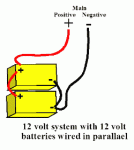coax
Adventurer
So in my reading about battery chargers, it was fairly clear that using a 3 stage charger to charge 2 12v batteries in parallel is not a great idea, as one battery could be over charged during the boost/absorption stage since one battery will be "full" and the other battery may not be. Which would leave the charger in Boost/Absorption mode for longer than it should be. My question is how this relates to solar panels, and what folks are doing to address this. Or if it even needs to be addressed. I ask because I am looking at putting a solar panel on my Landcruiser that has dual batteries, but also my parents recently bought a small camper with 2 12v batteries, a solar panel, and this charge controller:
http://www.amazon.com/Go-Power-GP-PWM-30-Solar-Regulator/dp/B007KIUDBQ
It is a 3 stage PWM controller, and according to the manual, it states it will do the following for 12v flooded batteries:
So my two questions are really this:
1. Is this something to worry about, having one battery of a dual battery system be over charged by the solar panel and 3 stage charge controller? The batteries are identical, but imagine they still have slight differences between the two?
2. In general i understand that 3 stage charging is also bad for unloaded batteries. In a setup such as an overland vehicle with a fridge or a camper with fridge/lights/etc, is a 3 stage solar controller appropriate?
Do they make dual independent outputs on solar controllers and then just put some sort of isolator inbetween? Or use a 2 stage charger and live with the lower effective capacity that it will provide since the batteries wouldn't charge all the way? Use a battery isolater such as the blue sea marine switch and hook up the solar panel to the start isolation so it only charges the house battery off the solar panel?
Thoughts? I did a bit of searching and found plenty on chargers and dual batteries but not much on solar and dual battery setups? Forgive me if I missed a thread where this is explained.
:beer:
http://www.amazon.com/Go-Power-GP-PWM-30-Solar-Regulator/dp/B007KIUDBQ
It is a 3 stage PWM controller, and according to the manual, it states it will do the following for 12v flooded batteries:
- Bulk: 14.4v
- Boost: 14.4v applied for 2 hours if voltage was below 12.3
- Float: 13.7
So my two questions are really this:
1. Is this something to worry about, having one battery of a dual battery system be over charged by the solar panel and 3 stage charge controller? The batteries are identical, but imagine they still have slight differences between the two?
2. In general i understand that 3 stage charging is also bad for unloaded batteries. In a setup such as an overland vehicle with a fridge or a camper with fridge/lights/etc, is a 3 stage solar controller appropriate?
Do they make dual independent outputs on solar controllers and then just put some sort of isolator inbetween? Or use a 2 stage charger and live with the lower effective capacity that it will provide since the batteries wouldn't charge all the way? Use a battery isolater such as the blue sea marine switch and hook up the solar panel to the start isolation so it only charges the house battery off the solar panel?
Thoughts? I did a bit of searching and found plenty on chargers and dual batteries but not much on solar and dual battery setups? Forgive me if I missed a thread where this is explained.
:beer:
Last edited:

